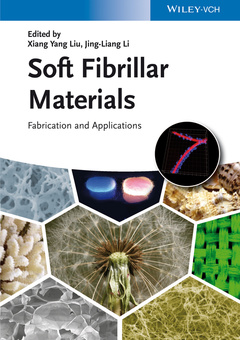Soft Fibrillar Materials Fabrication and Applications
Coordonnateurs : Li Jing Liang, Liu Xiang Yang

As one of the most important classes of soft materials, supramolecular materials are of a mixture of networks of molecular chains/fibrils and a liquid. These self-assembled fibrous/ molecular architectures exhibit various functionalities, ie. superhydrophobicity or superior mechanical strength, etc. and consist of the controllable structures.
They can be functioned via micro/nano engineering, to have some particular added functions, ie. emission materials, tissue engineering scaffolds, bio imaging and sensing materials etc. They have therefore found broad applications in photography, cosmetics, food and petroleum industries and not the least in the biomedical sector where there is strong interest in these materials as drug delivery agents.
The book covers the most important soft functional materials, including small molecule physical gels, silkworm silk and spider silk fibers and functional fibers, with respect both to the fundamentals and to development and engineering methods. It provides the reader with the necessary knowledge on the chemical and physical formation mechanisms of these materials and demonstrates that one can rationally design and tune the fibrillar networks so that the resulting materials exhibit the desired functionalities.
This work is a must-have for all Materials Scientists, Polymer Chemists, Condensed Matter Physicists, and Biotechnologists working in this interdisciplinary field.
MOLECULAR GELS AND THEIR FIBRILLAR NETWORKS
Introduction
Advances and Perspectives for Design of Gelators
Stimulation of Gelation by Perturbations Other Than Temperature
Kinetic Models for Following One-Dimensional Growth and Gelation
Advances and Perspectives for a Priori Design of Gelators
Some Final Thoughts
ENGINEERING OF SMALL-MOLECULE GELS BASED ON THE THERMODYNAMICS AND KINETICS OF FIBER FORMATION
Introduction
Fiber Networks of SMGs
Crystallization of Nanofibers
Strategies for Engineering the Micro/Nano Structure of Fiber Networks
Engineering the Macroscopic Properties of Gels by Design of Fiber Networks
Conclusions
APPLICATIONS OF SMALL-MOLECULE GELS - DRUG DELIVERY
Introduction
Hydrogels in Pharmaceutical Applications
Organogels in Pharmaceutical Applications
Organogel Delivery of Bioactive Factors in Regenerative Medicine
Future Directions: Hybrid Organogels
Conclusion
MOLECULAR GELS FOR TISSUE ENGINEERING
Introduction
Low-Molecular-Weight Gelators and Molecular Gels
Self-Assembly and Gel Structures
Applications of Hydrogels in Tissue Engineering
Summary
MOLECULAR GELS FOR CONTROLLED FORMATION OF MICRO-/NANO-STRUCTURES
Introduction
Structure of Metal/Transition Metal Oxide and Sulfate
Metallic Nanostructures
Controlled Formation of Organic and Composite Structures
Controlling Crystal Growth of Pharmaceutical Substances
Conclusions and Perspectives
SECTION II: Natural Silk Fibrous Materials
SPIDER SILK: STRUCTURE, ENGINEERING, AND APPLICATIONS
Introduction
Mechanical Design of Spider Silk
Mimicking Spider Silk
Applications
FUNCTIONALIZATION OF COLORED/FLUORESCENT SILKWORM SILK FIBROUS MATERIALS
Introduction
Legend and History of Silkworm Silk
The Structure of Silkworm Silk
Functionalization of Silkworm Silk
Summary and Outlook
SECTION III: Smart Fibers
FLEXIBLE NANOGENERATOR AND NANO-PRESSURE SENSOR BASED ON NANOFIBER
WEB OF PVDF AND ITS COPOLYMERS
Introduction
Electrospinning Mechanism and Set-up
Nanofiber Web
Piezoelectric Properties of Electrospun Web of PVDF and its Copolymer
Flexible Devices
Conclusion
ELECTROSPUN NANOFIBERS FOR REGENERATIVE MEDICINE
Introduction
Electrospinning of Nanofibers
Controlling the Alignment of Nanofibers
Nanofiber Scaffolds with Complex Architectures
Applications in Regenerative Medicine
Concluding Remarks
INDEX
Xiang Yang Liu is a Professor in the Department of Chemistry and the Department of Physics at the National University of Singapore (NUS). Having obtained his PhD degree from the Radboud University Nijmegen, The Netherlands, he spent his career working for Unilever Research Port Sunlight Lab before taking up his present appointment at NUS. Professor Liu has authored or co-authored more than 170 scientific publications and has received numerous scientific awards, including the 2007 Outstanding Researcher Award from NUS.
Date de parution : 11-2013
Ouvrage de 320 p.
17.5x25.2 cm
Disponible chez l'éditeur (délai d'approvisionnement : 14 jours).
Prix indicatif 137,26 €
Ajouter au panier